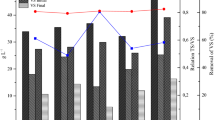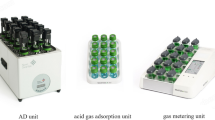Abstract
In the present study, we evaluated the biogas production from the anaerobic co-digestion of raw glycerol (RG) in combination with swine manure (SM) and the interaction of the microbial community during anaerobic co-digestion. In the same way, different RG and SM concentrations were examined in the range of 6 to 15 g L−1 and 7.5 to 22.5 g L−1, respectively. According to the results, the highest values for biogas yield and methane yield were observed in test 1(6 g RG/7.5 g SM) with 340 mL g−1 COD, test 2 (6 g RG/22.5 g SM) with 330 mL g−1 COD, test 4 (15 g RG/22.5 g SM) with 344 mL g−1 COD, and test 5 (3.75 g RG/15 g SM) with 328 mL g−1 COD. Although the concentration of substrates increases, glycerol remains between 20 and 21% of RG for both tests (2 and 5). An increase in the concentration of RG (> 21% w/w) generated inhibitory effects for the co-digestion process since there was an overload of organic acids, which increase the impurity concentration and lower the biogas yield. Thus, the microbial consortium is a function of the organic load of the RG/SM ratio. The greater the concentration of RG, the higher the population of clostridium and low biogas yield in anaerobic co-digestion.







Similar content being viewed by others
References
Puyol D, Batstone DJ, Hülsen T, Astals S, Peces M, Krömer JO (2017) Resource recovery from wastewater by biological technologies: opportunities, challenges, and prospects. Front Microbiol 7:1–23. https://doi.org/10.3389/fmicb.2016.02106
Khan MA, Ngo HH, Guo WS, Liu Y, Nghiem LD, Hai FI, Deng LJ, Wang J, Wu Y (2016) Optimization of process parameters for production of volatile fatty acid, biohydrogen and methane from anaerobic digestion. Bioresour Technol 219:738–748. https://doi.org/10.1016/j.biortech.2016.08.073
Weiland P (2010) Biogas production: current state and perspectives. Appl Microbiol Biotechnol 85:849–860. https://doi.org/10.1007/s00253-009-2246-7
Shuba ES, Kifle D (2018) Microalgae to biofuels: ‘promising’ alternative and renewable energy, review. Renew Sustain Energy Rev 81:743–755. https://doi.org/10.1016/j.rser.2017.08.042
Ponsá S, Gea T, Sánchez A (2011) Anaerobic co-digestion of the organic fraction of municipal solid waste with several pure organic co-substrates. Biosyst Eng 108:352–360. https://doi.org/10.1016/j.biosystemseng.2011.01.007
OECD, FAO, Meat, OECD-FAO Agric (2017) Outlook 2016–2025. Spec. Focus Sub-Saharan Africa. https://data.oecd.org/agroutput/meat-consumption.htm
Dennehy C, Lawlor PG, Croize T, Jiang Y, Morrison L, Gardiner GE, Zhan X (2016) Synergism and effect of high initial volatile fatty acid concentrations during food waste and pig manure anaerobic co-digestion. Waste Manag 56:173–180. https://doi.org/10.1016/j.wasman.2016.06.032
Konrad O, Koch FF, Lumi M, Tonetto JF, Bezama A (2014) Potential of biogas production from swine manure supplemented. Eng Agrícola 34:844–853. https://doi.org/10.1590/S0100-69162014000500004
Mariscal G (2007) Tratamiento Excretas Cerdos, FAO, Prod. Porc. 1–9. http://scholar.google.com/scholar?hl=en&btnG=Search&q=intitle:Tratamiento+excretas+cerdos#0. Accessed 23 Nov 2020
Kusch-Brandt (2021) Urban renewable energy on the upswing: a spotlight on renewable energy in cities in REN21’s “Renewables 2021 Global Status Report”. https://www.ren21.net/reports/global-status-report/. Accessed 23 Nov 2020
Ohimain EI (2007) A review of the Nigerian biofuel policy and incentives. Renew Sustain Energy Rev 22(2013):246–256. https://doi.org/10.1016/j.rser.2013.01.037
Kolesárová N, Hutan M, Bodík I, Špalková V (2011) Utilization of biodiesel by-products for biogas production. J Biomed Biotechnol. 2011. https://doi.org/10.1155/2011/126798
Valerio O, Horvath T, Pond C, Misra M, Mohanty A (2015) Improved utilization of crude glycerol from biodiesel industries: synthesis and characterization of sustainable biobased polyesters. Ind Crops Prod 78:141–147. https://doi.org/10.1016/j.indcrop.2015.10.019
Astals S, Nolla-Ardèvol V, Mata-Alvarez J (2012) Anaerobic co-digestion of pig manure and crude glycerol at mesophilic conditions: biogas and digestate. Bioresour Technol 110:63–70. https://doi.org/10.1016/j.biortech.2012.01.080
Nartker S, Ammerman M, Aurandt J, Stogsdil M, Hayden O, Antle C (2014) Increasing biogas production from sewage sludge anaerobic co-digestion process by adding crude glycerol from biodiesel industry. Waste Manag 34:2567–2571. https://doi.org/10.1016/j.wasman.2014.08.017
Athanasoulia E, Melidis P, Aivasidis A (2014) Co-digestion of sewage sludge and crude glycerol from biodiesel production. Renew Energy 62:73–78. https://doi.org/10.1016/j.renene.2013.06.040
Kanchanasuta S, Sillaparassamee O (2017) Enhancement of hydrogen and methane production from co-digestion of palm oil decanter cake and crude glycerol using two stage thermophilic and mesophilic fermentation. Int J Hydrogen Energy 42:3440–3446. https://doi.org/10.1016/j.ijhydene.2017.01.032
Fountoulakis MS, Manios T (2009) Enhanced methane and hydrogen production from municipal solid waste and agro-industrial by-products co-digested with crude glycerol. Bioresour Technol 100:3043–3047. https://doi.org/10.1016/j.biortech.2009.01.016
Wang X, Lu X, Li F, Yang G (2014) Effects of temperature and Carbon-Nitrogen (C/N) ratio on the performance of anaerobic co-digestion of dairy manure, chicken manure and rice straw: focusing on ammonia inhibition. PLoS ONE 9:1–7. https://doi.org/10.1371/journal.pone.0097265
González-Fernández C, García-Encina PA (2009) Impact of substrate to inoculum ratio in anaerobic digestion of swine slurry. Biomass Bioenerg 33:1065–1069. https://doi.org/10.1016/j.biombioe.2009.03.008
Yenigün O, Demirel B (2013) Ammonia inhibition in anaerobic digestion: a review. Process Biochem 48:901–911. https://doi.org/10.1016/j.procbio.2013.04.012
Palatsi J, Viñas M, Guivernau M, Fernandez B, Flotats X (2011) Anaerobic digestion of slaughterhouse waste: main process limitations and microbial community interactions. Bioresour Technol 102:2219–2227. https://doi.org/10.1016/j.biortech.2010.09.121
Ziganshin AM, Liebetrau J, Pröter J, Kleinsteruber S (2013) Microbial community structure and dynamics during anaerobic digestion of various agricultural waste materials. Appl Microbiol Biotechnol 97:5161–5174. https://doi.org/10.1007/s00253-013-4867-0
Da Silva C, Astals S, Peces M, Campos JL, Guerrero L (2017) Biochemical methane potential (BMP) tests: Reducing test time by early parameter estimation. Waste Manag 71:19–24. https://doi.org/10.1016/j.wasman.2017.10.009
Moody L, Burns R, Wu-Haan W, Spajić R (2009) Use of biochemical methane potential (BMP) assays for predicting and enhancing anaerobic digester performance. Proc 4th Int 44th Croat Symp Agric 930–934. http://sa.agr.hr/pdf/2009/sa2009_p1009.pdf
Labatut RA, Angenent LT, Scott NR (2011) Biochemical methane potential and biodegradability of complex organic substrates. Bioresour Technol 102:2255–2264. https://doi.org/10.1016/j.biortech.2010.10.035
Addison S, Slade A, Dennis M (2011) Effects of substrate composition on the structure of microbial communities in wastewater using fluorescence in situ hybridisation. Syst Appl Microbiol 34:337–343. https://doi.org/10.1016/j.syapm.2010.10.006
Marone A, Varrone C, Fiocchetti F, Giussani B, Izzo G, Mentuccia L, Rosa S, Signorini A (2015) Optimization of substrate composition for biohydrogen production from buffalo slurry co-fermented with cheese whey and crude glycerol, using microbial mixed culture. Int J Hydrogen Energy 40:209–218. https://doi.org/10.1016/j.ijhydene.2014.11.008
Sathish S (2011) Optimization of different parameters affecting biogas production from rice straw : an analytical approach. J Biogas 78–84. https://doi.org/10.5013/IJSSST.a.15.02.11
Aguilar-Aguilar FA, Longoria A, Juan Torena A, Sebastian PJ (2019) optimization of hydrogen yield from the anaerobic digestion of crude glycerol and swine manure. Catalysts. 9:316. https://doi.org/10.3390/catal9040316
Hitit ZY, Lazaro CZ, Hallenbeck PC (2017) Single stage hydrogen production from cellulose through photo-fermentation by a co-culture of Cellulomonas fimi and Rhodopseudomonas palustris. Int J Hydrogen Energy 42:6556–6566. https://doi.org/10.1016/j.ijhydene.2016.12.035
American Public Health Association (1995) Standard Methods for the Examination of Water and Wastewater (APHA), 21st ed., 21st ed. American Water Environment Federation, Washington, DC. https://smww.aphapublications.org/
Ghosh D, Sobro IF, Hallenbeck PC (2012) Stoichiometric conversion of biodiesel derived crude glycerol to hydrogen: Response surface methodology study of the effects of light intensity and crude glycerol and glutamate concentration. Bioresour Technol 106:154–160. https://doi.org/10.1016/j.biortech.2011.12.021
Khuri AI, Mukhopadhyay S (2010) Response surface methodology, Wiley Interdiscip. Rev Comput Stat 2:128–149. https://doi.org/10.1002/wics.73
Aguilar-Aguilar AS, Nelson FA, Pantoja DL, Santos LA (2017). Study of anaerobic co-digestion of crude glycerol and swine manure for the production of biogas study of anaerobic co-digestion of crude glycerol and swine manure for the production of biogas. Rev Virtual Quím 9 https://doi.org/10.21577/1984-6835.20170142
Chernicharo CAL (2007) Biological Wastewater Treatment Vol.4: Anaerobic Reactors, IWA Publishing. https://doi.org/10.1017/CBO9781107415324.004
L.O. Aquino, F.S., Chernicharo C.A.L. Foresti E.Florêncio M.L.S., Monteggia (2007) Metodologias para determinação da Atividade Metanogênica Específica (AME) em Lodos Anaeróbios. Eng Sanit Ambient 12: 192–201. https://doi.org/10.1590/S1413-41522007000200010
Green MR, Sambrook J (2012) Chapter I, isolation and quantification of DNA. https://doi.org/10.3724/SP.J.1141.2012.01075
Klindworth A, Pruesse E, Schweer T, Peplies J, Quast C, Horn M, Glöckner FO (2013) Evaluation of general 16S ribosomal RNA gene PCR primers for classical and next-generation sequencing-based diversity studies. Nucleic Acids Res 41:1–11. https://doi.org/10.1093/nar/gks808
Magoč T, Salzberg SL (2011) FLASH: Fast length adjustment of short reads to improve genome assemblies. Bioinformatics 27:2957–2963. https://doi.org/10.1093/bioinformatics/btr507
Essid M, Trabelsi K, Jerbi E, Boubaker S, Gorgi Y, Ayed K, Azzouz MM (2003) L’atrophie villositaire au cours de l’epilepsie essentielle. Tunisie Med 81:270–272. https://doi.org/10.1371/journal.pone.0089323
Bengtsson-Palme J, Hartmann M, Eriksson KM, Pal C, Thorell K, Larsson DGJ, Nilsson RH (2015) metaxa2: improved identification and taxonomic classification of small and large subunit rRNA in metagenomic data. Mol Ecol Resour 15:1403–1414. https://doi.org/10.1111/1755-0998.12399
Escobar-Zepeda A, Godoy-Lozano EE, Raggi L, Segovia L, Merino E, Gutiérrez-Rios RM, Juarez K, Licea-Navarro AF, Pardo-Lopez L, Sanchez-Flores A (2018) Analysis of sequencing strategies and tools for taxonomic annotation: defining standards for progressive metagenomics. Sci Rep 8:1–13. https://doi.org/10.1038/s41598-018-30515-5
McMurdie PJ, Holmes S (2013) Phyloseq: An R package for reproducible interactive analysis and graphics of microbiome census data, PLoS One 8. https://doi.org/10.1371/journal.pone.0061217
R.K. Jari Oksanen, F. Guillaume Blanchet, Michael Friendly, R.B.O. Pierre Legendre, Dan McGlinn, Peter R. Minchin, E.S. Gavin L. Simpson, Peter Solymos, M. Henry H. Stevens, H. Wagner (2018) Community Ecology Package. ISBN 0–387–95457–0.
Bharathiraja B, Sudharsanaa T, Bharghavi A, Jayamuthunagai J, Praveenkumar R (2016) Biohydrogen and biogas – an overview on feedstocks and enhancement process. Fuel 185:810–828. https://doi.org/10.1016/j.fuel.2016.08.030
Glanpracha N, Annachhatre AP (2016) Anaerobic co-digestion of cyanide containing cassava pulp with pig manure. Bioresour Technol 214:112–121. https://doi.org/10.1016/j.biortech.2016.04.079
J. Fierro, E.J. Martinez, J.G. Rosas, R.A. Fern??ndez, R. Lopez, X. Gomez (2016) Co-digestion of swine manure and crude glycerine: increasing glycerine ratio results in preferential degradation of labile compounds. Water Air Soil Pollut 227. https://doi.org/10.1007/s11270-016-2773-7
Astals S, Musenze RS, Bai X, Tannock S, Tait S, Pratt S, Jensen PD (2015) Anaerobic co-digestion of pig manure and algae: impact of intracellular algal products recovery on co-digestion performance. Bioresour Technol 181:97–104. https://doi.org/10.1016/j.biortech.2015.01.039
Viana MB, Freitas AV, Leitão RC, Pinto GAS, Santaella ST (2012) Anaerobic digestion of crude glycerol: a review. Environ Technol Rev 1:81–92. https://doi.org/10.1080/09593330.2012.692723
Siles JA, Martín MA, Chica AF, Martín A (2010) Anaerobic co-digestion of glycerol and wastewater derived from biodiesel manufacturing. Bioresour Technol 101:6315–6321. https://doi.org/10.1016/j.biortech.2010.03.042
Zeng S, Yuan X, Shi X, Qiu Y (2010) Effect of inoculum/substrate ratio on methane yield and orthophosphate release from anaerobic digestion of Microcystis spp. J Hazard Mater 178:89–93. https://doi.org/10.1016/j.jhazmat.2010.01.047
Eskicioglu C, Ghorbani M (2011) Effect of inoculum / substrate ratio on mesophilic anaerobic digestion of bioethanol plant whole stillage in batch mode. Process Biochem 46:1682–1687. https://doi.org/10.1016/j.procbio.2011.04.013
Nghiem LD, Nguyen TT, Manassa P, Fitzgerald SK, Dawson M, Vierboom S (2014) Co-digestion of sewage sludge and crude glycerol for on-demand biogas production. Int Biodeterior Biodegrad 95:160–166. https://doi.org/10.1016/j.ibiod.2014.04.023
Wang L, Liu W, Kang L, Yang C, Zhou A, Wang A (2014) Enhanced biohydrogen production from waste activated sludge in combined strategy of chemical pre-treatment and microbial electrolysis. Int J Hydrogen Energy 39:11913–11919. https://doi.org/10.1016/j.ijhydene.2014.06.006
S. Baena, M. Fardeau, B. Ollivier, M. Labat, P. T, A. De (1993) A mesophilic, anaerobic, amino-acid-utilizing bacterium. Int J Syst Bacteriol
Yamada T, Imachi H, Ohashi A, Harada H, Hanada S, Kamagata Y, Sekiguchi Y (2007) Bellilinea caldifistulae gen. nov., sp. nov and Longilinea arvoryzae gen. nov., sp. nov., strictly anaerobic, filamentous bacteria of the phylum Chloroflexi isolated from methanogenic propionate-degrading consortia. Int J Syst Evol Microbiol 57:2299–2306. https://doi.org/10.1099/ijs.0.65098-0
Rubiano-Labrador C, Baena S, Díaz-Cárdenas C, Patel BKC (2013) Caloramator quimbayensis sp. nov., an anaerobic, moderately thermophilic bacterium isolated from a terrestrial hot spring. Int J Syst Evol Microbiol 63:1396–1402. https://doi.org/10.1099/ijs.0.037937-0
Guo Y, Zeng W, Li N, Peng Y (2018) Effect of electron acceptor on community structures of denitrifying polyphosphate accumulating organisms in anaerobic-anoxic-oxic (A2O) process using DNA based stable-isotope probing (DNA-SIP). Chem Eng J 334:2039–2049. https://doi.org/10.1016/j.cej.2017.11.170
Tian H, Duan N, Lin C, Li X, Zhong M (2015) Anaerobic co-digestion of kitchen waste and pig manure with different mixing ratios. J Biosci Bioeng 120:51–57. https://doi.org/10.1016/j.jbiosc.2014.11.017
Acknowledgements
The authors acknowledge Christian García Hernández for collaborating in the review of this study.
Funding
The authors acknowledge the financial support received through the project DGAPA-UNAM PE210918 and IN109319. The technical support received from the Laboratorio de Investigación en Procesos Avanzados de Tratamiento de Aguas (LIPATA) of the Unidad Académica Juriquilla, Campus UNAM, Juriquilla, Querétaro is highly appreciated.
Author information
Authors and Affiliations
Corresponding author
Additional information
Publisher's note
Springer Nature remains neutral with regard to jurisdictional claims in published maps and institutional affiliations.
Rights and permissions
About this article
Cite this article
Aguilar-Aguilar, F., Adaya, L., Godoy-Lozano, E.E. et al. Anaerobic co-digestion of raw glycerol and swine manure: microbial communities. Biomass Conv. Bioref. 13, 7127–7138 (2023). https://doi.org/10.1007/s13399-021-01914-y
Received:
Revised:
Accepted:
Published:
Issue Date:
DOI: https://doi.org/10.1007/s13399-021-01914-y




